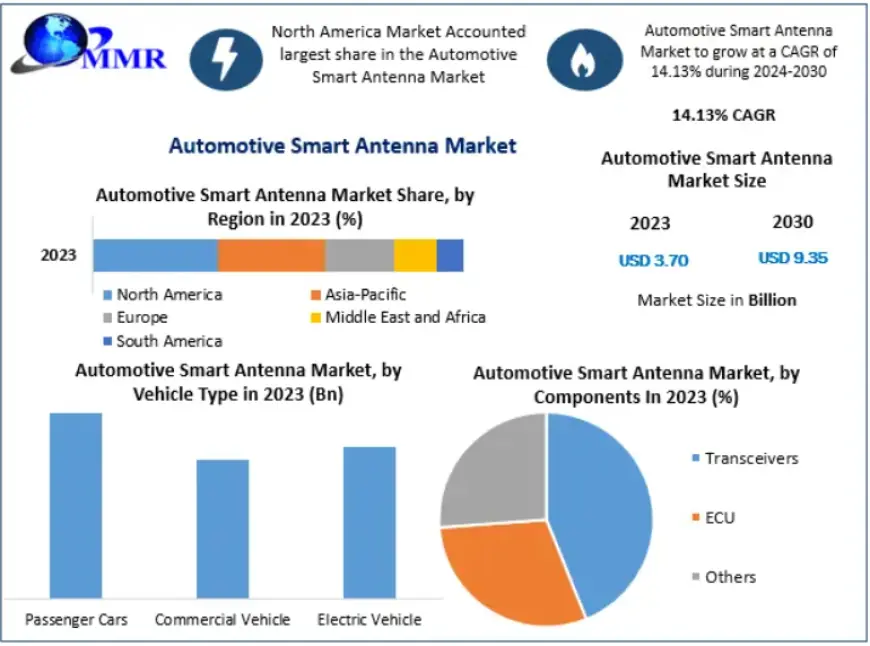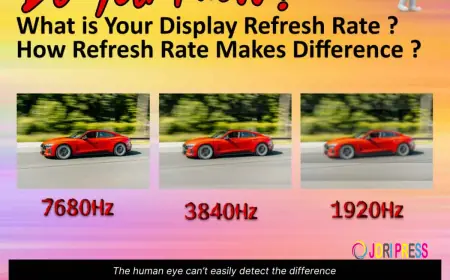Automotive Smart Antenna Market Size, Share, and Forecast Analysis 2030
Automotive Smart Antenna Market is expected to reach US$ 9.35 Bn by 2030, at a CAGR of 14.13% during the forecast period.

Global Automotive Smart Antenna Market Expected to Accelerate from USD 3.70 Billion in 2023 to USD 9.35 Billion by 2030
The Global Automotive Smart Antenna Market is on a steep growth trajectory, with the industry valued at approximately USD 3.70 billion in 2023, projected to reach USD 9.35 billion by 2030, delivering a robust Compound Annual Growth Rate (CAGR) of 14.13% over the 2024–2030 forecast period.
Market Estimation & Definition
Market Size (2023): USD 3.70 billion
Projected Market Size (2030): USD 9.35 billion
Forecast CAGR (2024–2030): 14.13%
Definition:
An automotive smart antenna is a sophisticated signal reception and transmission system integrated into modern vehicles. It supports diverse communication functions—including GPS, Wi-Fi, cellular, Bluetooth, radio, e-call, and infotainment systems—often leveraging wireless rather than traditional wired connections. Positioned strategically (e.g., embedded in spoilers or roofs), smart antennas mitigate signal loss while enabling multi-modal connectivity essential for navigation, telematics, safety, and infotainment.
To know the most attractive segments, click here for a free sample of the report:https://www.maximizemarketresearch.com/request-sample/70933/
Market Growth Drivers & Opportunity
Primary Growth Drivers:
-
Connected Vehicle Demand: As the automotive industry transitions to smarter, more connected vehicles, reliance on versatile antenna systems has intensified. The volume of internet-enabled, infotainment-rich vehicles has surged, creating strong demand for integrated smart antennas.
-
Autonomous & Electric Vehicle (EV) Expansion: The rise in electric and autonomous vehicle adoption necessitates advanced connectivity. Smart antennas support critical functions such as navigation assistance, over-the-air updates, V2X communication, and telematics.
-
Regulatory Safety Mandates: Increasing security and safety standards—requiring systems like e-call and infrastructure connectivity—drive OEMs to adopt integrated smart antenna solutions.
-
Technological Innovation: Adoption of multi-input/multi-output (MIMO), beamforming, 5G integration, and compact embedded designs enhances antenna efficiency and performance, fueling modernization.
Emerging Opportunities:
-
EV-Targeted Enhancements: Emphasis on seamless infotainment and longer-range communication within EVs unlocks growth avenues for smart antenna makers.
-
Multi-Modal Connectivity: The need to support an array of frequencies (GPS, cellular, VHF/UHF, Wi-Fi, satellite) opens doors for multi-functional antenna platforms.
-
Aftermarket Expansion: While OEMs dominate today, upgraded or replacement smart antenna solutions offer significant aftermarket potential, especially for older vehicle segments.
Challenges to Monitor:
-
Infrastructure & Interoperability: Vehicles’ reliance on external communication networks presents integration challenges in less-equipped regions.
-
Data Handling & Privacy Considerations: The increasing volume of transmitted and collected data raises concerns about security, compliance, and user privacy protocols.
Segmentation Analysis
The market is analyzed across four main dimensions:
By Frequency Band:
-
High Frequency – Standard broadcast and communication.
-
Very High Frequency (VHF) – Dominant in the market, facilitating emergency, radio, and mid-range connectivity.
-
Ultra-High Frequency (UHF) – For high-bandwidth functions with advanced signal requirements.
By Vehicle Type:
-
Passenger Cars – The largest segment, where infotainment and personal connectivity are high.
-
Commercial Vehicles – Growing with fleet connectivity, logistics tracking, and V2X demands.
-
Electric Vehicles (EVs) – The fastest-growing category, leveraging smart antenna integration for EV-specific systems.
By Component:
-
ECU (Electronic Control Unit) – Critical for managing communication functions and leading adoption in the forecast period.
-
Transceivers – Transmits and receives signals across frequency bands.
-
Others – Includes wiring harnesses, amplifiers, filters, connectors, etc.
By Sales Channel:
-
OEM (Original Equipment Manufacturer) – The primary channel, delivering embedded solutions to vehicle manufacturers.
-
OES (Original Equipment Supplier) – Parts tailored for system integrators or assemblers.
-
IAM (Independent Aftermarket) – Replacement or upgrade parts sold post-manufacture.
To know the most attractive segments, click here for a free sample of the report:https://www.maximizemarketresearch.com/request-sample/70933/
Country-Level Analysis: USA & Germany
United States
-
The U.S. automotive smart antenna market benefits from strong demand for in-vehicle connectivity, including infotainment, navigation, and emerging autonomous features.
-
While specific figures are limited, the U.S. is a major part of the North American growth trend, with base technology infrastructure and adoption capabilities that drive steady expansion through both OEM and aftermarket channels.
Germany
-
Backed by a globally competitive automotive sector, Germany supports advanced smart antenna deployment—particularly in premium and electric vehicle segments.
-
Strong focus on sustainability and high connectivity standards positions German automakers to be leaders in integrated smart antenna applications.
-
Though exact forecasts aren't publicly detailed, Germany benefits from robust innovation, green mobility policies, and premium vehicle demand, likely resulting in growth rates above the European average.
Comparator Analysis
To validate projections, several external market studies were evaluated:
-
Grand View Research forecasts global smart antenna market to grow from approx. USD 2,787 million in 2024 to significantly higher by 2030, at a CAGR of roughly 12.3%.
-
Allied Market Research estimates market value rising from USD 3.5 billion (2023) to USD 6.2 billion by 2033—CAGR ~6.2%.
-
Business Research Company projects a growth from USD 2.85 billion (2024) to USD 4.01 billion by 2029, ~7.1% CAGR.
-
Data Bridge anticipates expansion from USD 4.69 billion (2024) to USD 14.66 billion by 2032, ~15.3% CAGR.
-
Verified Market Research forecasts growth from USD 3.62 billion (2023) to USD 11.77 billion by 2031, CAGR ~15.9%.
-
MarketMinds Advisory projects USD 7.25 billion by 2025, reaching USD 17.3 billion by 2035—CAGR ~9.1%.
Insight: While forecast figures vary, supervisory consensus demonstrates strong, double-digit compound annual growth. The Maximize projection (14.13%) aligns well within this range, reflecting both conservative and aggressive estimates from other sources.
Press Release Conclusion
The global automotive smart antenna market is rapidly evolving—from a USD 3.70 billion industry in 2023 to an anticipated USD 9.35 billion by 2030, growing at a compelling 14.13% CAGR. Fueled by the rise of connected and electric vehicles, regulatory imperatives, and cutting-edge technological innovations (like multi-band integration, MIMO, and 5G), smart antennas have become a cornerstone of modern automotive design.
Regional powerhouses such as the USA and Germany demonstrate varied strengths: the former through infrastructure and tech adoption, the latter through premium and sustainable vehicle engineering. The market’s strong segmentation across frequency bands, vehicle categories, component types, and sales channels underscores vast opportunities ahead for OEMs, suppliers, and aftermarket players alike.
As wave after wave of technological transformation sweeps the auto industry—from electrification to autonomy to IoT—the automotive smart antenna emerges not just as a component, but as a strategic enabler of the future's mobility ecosystem.
What's Your Reaction?
 Like
0
Like
0
 Dislike
0
Dislike
0
 Love
0
Love
0
 Funny
0
Funny
0
 Angry
0
Angry
0
 Sad
0
Sad
0
 Wow
0
Wow
0















































